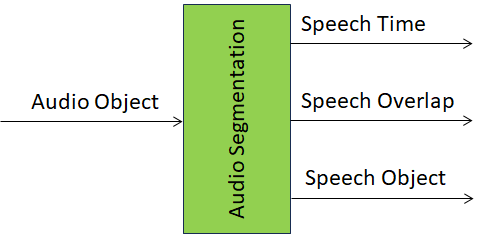| 1 Function | 2 Reference Model | 3 Input/Output Data |
| 4 SubAIMs | 5 JSON Metadata | 6 Profiles |
| 7 Reference Software | 8 Conformance Texting | 9 Performance Assessment |
1 Functions
Audio Segmentation (MMC-AUS):
| Receives | Audio Object | Audio to be segmented including speech and audio. |
| Identifies | Speech Time | Time of audio segmentation. |
| Extracts | Target Speech Objects | Speech Object to be extracted. |
| Detects | Speech Overlap | Data Type about speech overlap. |
| Produces | Speech Time | Duration of speech segment. |
| Speech Overlap | Data Type about speech overlap. | |
| Speech Objects | Each Speech Object includes a Speaker’s Turn, i.e., one or more adjacent utterances from the same Speaker. |
2 Reference Model
Figure 1 depicts the Reference Model of the Audio Segmentation (MMC-AUS) AIM.

Figure 1 – Reference Model of Audio Segmentation (MMC-AUS) AIM
3 Input/Output Data
Table 1 specifies the Input and Output Data of the Audio Segmentation (MMC-AUS) AIM.
Table 1 – I/O Data of the Audio Segmentation (MMC-AUS) AIM
| Input | Description |
| Audio Object | Input Audio in a file. |
| Output | Description |
| Speaker Time | Time one or more Speakers start speaking. |
| Speech Overlap | Number of overlapping speakers. |
| Speech Object | Speech Object containing the utterance(s) of the Speaker(s). |
4 SubAIMs
No SubAIMs
5 JSON Metadata
https://schemas.mpai.community/MMC/V2.3/AIMs/AudioSegmentation.json
6 Profiles
No Profiles.
7 Reference Software
7.1 Disclaimers
- This MMC-AUS Reference Software Implementation is released with the BSD-3-Clause licence.
- The purpose of this MMC-AUS Reference Software is to show a working Implementation of OSD-AUS, not to provide a ready-to-use product.
- MPAI disclaims the suitability of the Software for any other purposes and does not guarantee that it is secure.
- Use of this Reference Software may require acceptance of licences from the respective repositories. Users shall verify that they have the right to use any third-party software required by this Reference Software.
7.2 Guide to the code
MMC-AUS splits the input WAV file into speech segments – called speakers’ turns – a belonging to one – still unidentified speaker. See see “start and end times of each speaker’s turn, as well as the speaker labels” at https://www.aimodels.fyi/models/huggingFace/speaker-diarization-pyannote. A turn is defined as a sequence of one or more speech segments belonging to the same speaker. See https://dokumen.pub/speech-recognition-technology-and-applications-9798886971798.html.
Use of this Reference Software for MMC-AUS AI Module is for developers who are familiar with Python, Docker, RabbitMQ, and downloading models from HuggingFace.
The MMC-AUS Reference Software is found at the MPAI gitlab site. It contains:
- src: a folder with the Python code implementing the AIM
- Dockerfile: a Docker file containing only the libraries required to build the Docker image and run the container
- requirements.txt: dependencies installed in the Docker image
- README.md: commands for cloning https://huggingface.co/speechbrain/spkrec-ecapa-voxceleb and https://huggingface.co/pyannote/segmentation
- diar_conf.yaml: YML setting up a diarization pipeline. Copy it to $AI_FW_DIR/confs/mmc_aus
Library: https://github.com/pyannote/pyannote-audio
7.3 Acknowledgements
This version of the OSD-AUS Reference Software has been developed by the MPAI AI Framework Development Committee (AIF-DC).
8 Conformance Testing
Table 2 provides the Conformance Testing Method for Audio Segmentation (MMC-AUS) AIM.
If a schema contains references to other schemas, conformance of data for the primary schema implies that any data referencing a secondary schema shall also validate against the relevant schema, if present and conform with the Qualifier, if present.
Table 2 – Conformance Testing Method for Audio Segmentation (MPAI-MMC) AIM
| Input | Audio Object | Shall validate against Audio Object schema. Audio Data shall conform with Audio Qualifier. |
| Output | Speaker Time | Shall validate against Time schema. |
| Speech Overlap | Shall validate against Speech Overlap schema. | |
| Speech Object | Shall validate against Speech Object schema. |
9 Performance Assessment
Performance Assessment of an MMC-AUS AIM Implementation shall be performed using a dataset of Audio segments that has been annotated with Time and type of Data (single speech, overlapped speech, or overlapped audio and one or more speech segments).
The Performance Assessment Report of an MMC-AUS AIM Implementation shall include:
- The Identifier of the MMC-AUS AIM.
- The Identifier of the non-annotated dataset of audio segments (if available).
- The Identifier of the annotated dataset of audio segments (if available).
- The number of Audio segments in the data base (the number of segments in #2. and #3. shall be the same).
- The Arithmetic Mean of
- The differences between Times of Speech Data computed by the MMC-AUS AIM and the annotated Times.
- Errors of more than 0.2 seconds in the identification of Speech Data Times.

